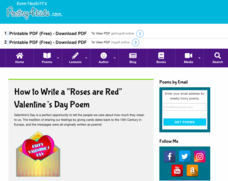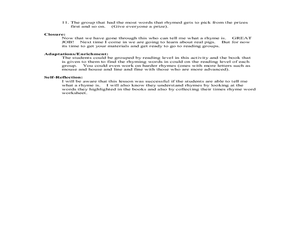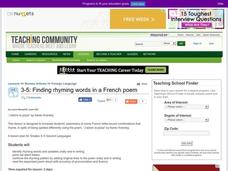National Council of Teachers of English
Writing Poetry with Rebus and Rhyme
Young scholars write rhyming poems using rebus. With pictures instead of words, authors create original work about things they love.
Poetry4kids
How to Write a Limerick
Add a little fun and fancy to English language arts with an activity that challenges scholars to write a limerick. Authors follow five rules in order to compose an original poem that contains a specific rhyme scheme.
Core Knowledge Foundation
Unit 7: Poetry
Over the course of a 12-lesson language arts unit, young scholars analyze a variety of poems taking a close look at figurative language and tone. They learn to compare and contrast, improve comprehension, and identify settings. To...
Poetry4kids
How to Write a “Roses are Red” Valentine’s Day Poem
Compose a Valentine's Day poem! Practicing their rhyming skills, scholars follow the traditional format to create a happy poem for a friend or family member.
Hong Kong Special Administrative Region
Learning English through Poems and Songs
Exposing learners to the power of words in poetry is a stimulating way to learn languages. Songs, haikus, rhyming words, and narrative works are all employed in a resource for teaching English as a Second Language.
Poetry4kids
How to Write a Fractured Nursery Rhyme
Scholars take a popular song or nursery rhyme and make it their own as they write a fractured nursery rhyme. Writers seek out a nursery rhyme's rhyming words and change them to create an original poem.
Read Write Think
Poetry Portfolios: Using Poetry to Teach Reading
Over the course of five periods, scholars create a poetry portfolio. They begin with a reading of the poem, Firefly. With a focus on vocabulary, learners reread the poem then look for sight words and other skills.
Poetry4kids
How to Write an Alliteration Poem
Learners follow five steps to compose an alliteration poem. They choose one consonant and brainstorm as many nouns, verbs, and adjectives they can think of to create rhyming sentences that come together in a poetic fashion.
Curated OER
The Wonderful Pigs of Jillian Jiggs: Rhyming Words
Readers explore rhyming words. They will use the story The Wonderful Pigs of Jillian Jiggs to identify rhyming words. Then they will create their own lists of rhyming words. In the end, they will be able to come up with words that rhyme...
K12 Reader
Poetry Uses Rhyme
It's rhyme time! After reading a short article about poems that rhyme, kids take the time answer questions about the message of the passage.
Curated OER
Finding Rhyming Words in a French Poem
Explore rhyming in this phonemic awareness and French lesson plan. Listen to the poem "J'Adore la Pizza" by Karen Kransky and identify rhyming words. Compare grapheme spelling patterns with like phonemes, and sort word cards according to...
Curated OER
Mouse Mess
Scholars practice rhyming and phonemic awareness using trade books and poetry. They will listen to the book Mouse Mess several times throughout the week, identifying rhyming words, and matching words that begin with the same sound. Then...
Curated OER
Rhyming Word Poems
Students create poetry. In this poetry lesson, students read poetry and identify rhyming words using highlighters. Students may also add rhyming lines to the poetry they read.
K12 Reader
The Thin Pin Can Spin
Words that end with -in are the focus on this worksheet. Learners read a short poem that includes quite a few -in words to identify and practice and then answer three reading comprehension questions.
K12 Reader
Will You Stay and Play?
Start off your day with a study of -ay words. Pupils can practice long a with -ay words by reading the brief poem included here. After they read, class members answer three reading comprehension questions right on the page.
K12 Reader
The Spy Will Try Not to Cry
Learn all about the exploits of a sly spy from the short poem included on this resource. The poem, intended to provide practice with long /i/ words that use the letter y, is paired with three reading comprehension questions for pupils to...
K12 Reader
Snack in the Sack
Get those -ack words straight with a quick exercise. Class members read a short poem that includes quite a few -ack words and then complete three reading comprehension questions.
K12 Reader
The Big Pig
Pigs are often big, but what else can your class find out about this particular pig? They'll learn a few things about it by reading the poem full of -ig words, and then answering the three reading comprehension questions.
K12 Reader
Drop the Mop!
Combine a study of -op words with a bit of reading comprehension. Learners read a quick a silly poem containing many -op words and then answer three questions.
K12 Reader
A Job for Bob
Get a handle on -ob words with a quick exercise. Learners first read a brief poem made up with many -ob words. They then response to three reading comprehension questions that are included on the page.
K12 Reader
Shut the Hut
Go with your gut and try out this worksheet that focuses on -ut words! Learners read a brief poem that includes many different words that end in -ut and then respond to three reading comprehension questions.
K12 Reader
The Snow Blows
Brrr! It's cold outside when it snows. Have your class read this poem about the snow to practice the long /o/ sound, -ow words, and reading comprehension. After reading, they respond to three questions.
Poetry4kids
Rhyme Schemes Lesson Plan
Scholars read four brief poems and analyze their word usage in order to identify the rhyme scheme.
Curated OER
Rhyming With Pancakes
Students read a story. In this rhyming lesson, students define the word rhyme and brainstorm words that rhyme with hat. Students read The Great Pancake Escape and practice reciting each of the verses. Students are given a list of words...























